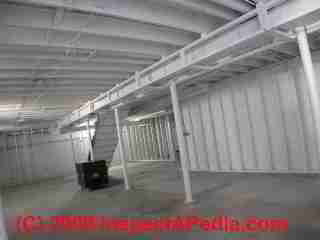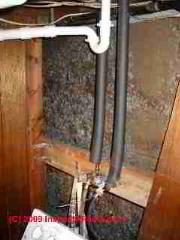 Insulating Board Sheathing Flood & Mold FAQs
Insulating Board Sheathing Flood & Mold FAQs
Q&A on repair of flood damaged fiberboard sheathing
- POST a QUESTION or COMMENT about mold on fiberboard building products
Flood-Damaged fiberboard insulating board or IB sheathing FAQs:
Questions & answers on insulating-board water damage, flood damage & occurrence & detection of mold contamination on fiberboard & wood-fiber-based insulating board sheathing.
This article series discusses flood damage and mold damage on fiberboard insulating products and building sheathing products such as Homasote, Celotex, and Masonite insulating board sheathing.
We describe alternative procedures for removal of moldy or flood damaged insulating board sheathing, assessing insulating board (IB) mold contamination, and wall repair or restoration options after fiberboard has been removed.
InspectAPedia tolerates no conflicts of interest. We have no relationship with advertisers, products, or services discussed at this website.
- Daniel Friedman, Publisher/Editor/Author - See WHO ARE WE?
FAQs on Flood Damaged, Moldy Fiberboard Sheathing Repairs
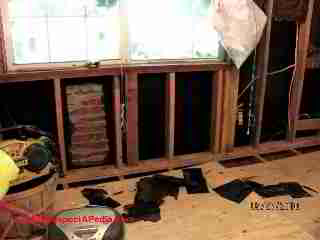 These questions & answers about how to remove & clean-up water or flood damaged or moldy insulating board (B) sheathing & repair options for flood damaged brick veneer homes were posted originally
These questions & answers about how to remove & clean-up water or flood damaged or moldy insulating board (B) sheathing & repair options for flood damaged brick veneer homes were posted originally
at BRICK VENEER WALL REPAIRS in FLOOD PRONE AREAS
or at this companion article FIBERBOARD SHEATHING MOLD CONTAMINATION
Remove vs Keep Fiberboard Exterior Wall Sheathing after Flooding
(Sept 4, 2016) Anonymous said:
I live in Denham Springs, LA and we just experienced a major flood a couple weeks ago. Our home has been gutted and treated for mold but I'm worried about this blackboard (possibly Celotex?) not being dry enough.
After mentioning it to friends that also flooded they shared info they were told by their insurance (we don't have flood ins). We had between 10-12 inches of water in our house, will this material dry out?
Taking out the brick to replace it sounds crazy expensive but we don't want to enclose it and possibly cause mold growth. Help please! I should mention that it's only in a few areas of our home-along a section of the wall of our kitchen and along a section of the bathroom and into the master bedroom.
Basically it's on the "sides" of our home not the front or back walls, those have plywood.
On 2016/09/22 Flooding in Baton Rouge LA: replace exterior sheathing from the inside?
My parents have a similar experience in Baton Rouge, LA. They had 20 inches of water and the house has brick veneer all the way around. The flood insurance company is saying that they'll pay for the replacement of the outside sheathing, but it must be done from the inside (sounds crazy).
They're saying there's a method "They will remove it between studs and replace it the same way using cross bracing to support it in place. " I can't seems to find anyone that's ever heard of this method.
On 2016-09-26 by CRS - Contractor opinion on mold remediation of flooded homes in Baton Rouge & Denham Springs: brick veneer over fiberboard
I am a contractor that has been working on this flood since we could get out. I am currently working on several homes in the Baton Rouge and Denham Springs area. The majority of the homes that have a brick veneer on the exterior will see the mineral fiberboard (black press board Georgia Pacific or similar to Celotex) excluding the corners of the house.
This has to be a structurally rated plywood to meet the wind load. I have been in this business for 30 years.
I have never removed exterior sheeting from the inside. The only way you can do this and still meet the manufactures specifications is to install it per the specification which ultimately means from the exterior. The insurance companies are feeding these flood victims a line of garbage.
Your claim will include the replacement cost of the materials but not the exterior brick removal and repair as this will in most cased exceed the limits of the policy.
There is a product on the market that can be applied to properly clean these surfaces.
Most of these products are wood fiber infused with an asphalt treatment. There should not be a problem down the road with product failure since they are rated for exterior use. They were designed to get wet
On 2016/10/04 Flood Survivor wants to kill the mold since it's hard and expensive to remove
I am also dealing with the 1970 backer board and fiber board behind a brick veneer wall and would desperately like to find someone who can tell me how to properly fix this without removing the entire wall.
CRS [a flood damage repair contractor whose comments are below] seems to know a lot about this and even suggested a product that will clean the surface.
How can I either get in touch with CRS or find out the name of this product? - Flood Survivor
Remove fiberboard wall sheathing behind a brick veneer wall that was flooded: leave the veneer wall
OPINION: I agree with that water-damaged and moldy fiberboard (or gypsum board) sheathing behind the cladding or brick or stone veneer walls is a serious problem, and one we've discussed with other flood victims in Louisiana, Texas and Florida and who are trying to do building restoration.
Wet or moldy sections of fiberboard sheathing, also referred to as insulating board or IB or by a specific product trade name like Homasote™, Celotex™ or GoldBond™ (a gypsum board sheathing product) that has been flooded usually needs to be replaced.
Removing the brick veneer to replace flood damaged wall sheathing is indeed ruinously expensive and worse, that repair approach will not prevent future damage at the next flood.
Some fiberboard products will be swollen and damaged by water but might not be mold reservoirs. But planning to leave that material in place invites future failures in exterior siding, siding connectors to the building framing, buckled siding, and possibly the later discovery of a costly and dangerous mold reservoir that should have been removed.
Fiberboard was not "designed to get wet" as CRS offered in his opinion. Fiberboard or insulating board was traditionally treated with a water resistant surface coating such as wax or asphalt; that product was designed to shed water or to resist moisture.
Nothing in the product specifications for these products describes resistance to area flooding that leaves the insulating board literally under water, often for days or even weeks.
Fiberboard insulating sheathing is not a waterproof material.
See FIBERBOARD PROTECT from WATER.
What are the risks of leaving a harmful mold reservoir in a building?
Plenty: future illnesses among building occupants, serious health risks for people who may be particularly sensitive to mold spores or MVOCs, such as asthmatics, immune-impaired occupants, infants, or the elderly; future costs to have to perform extensive demolition and cleanup of moldy materials that should have been removed during the first repair.
After wet and flood damaged materials have been removed and mold has been cleaned from remaining hard surfaces such as solid wood framing, plywood, or painted masonry, I'd consider using a fungicidal sealant to reduce future moisture uptake and thus improve the mold resistance of those materials left in place.
At BRICK VENEER WALL REPAIRS in FLOOD PRONE AREAS we describe repair procedures to remove flood or water-damaged or moldy fiberboard sheathing behind a brick veneer wall and how to repair the exposed wall cavity to reduce future water damage from flooding.
See FUNGICIDAL SEALANT USE GUIDE and also
see DISINFECTANTS, SANITIZERS, FUNGICIDAL-SEALANTS SOURCES to use these coatings.
See MOLD SANITIZER, SPRAY, BIOCIDE USE GUIDE for a "how-to" discussion of pros and cons of doing so.
Watch out: using a spray sanitizer or sealant or fungicidal paint is not a substitute for removing moldy drywall, wet insulation, nor does it subsitute for cleaning remaining moldy surfaces such as framing or wall sheathing.
Add Structural Support Against Racking or Wind Damage?
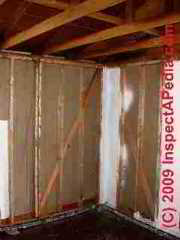 Watch out: where IB or fiberboard sheathing was used on a building's exterior you should inspect the building wall corners for wood or metal bracing that is intended to protect the structure from leaning or racking during high winds.
Watch out: where IB or fiberboard sheathing was used on a building's exterior you should inspect the building wall corners for wood or metal bracing that is intended to protect the structure from leaning or racking during high winds.
Wind bracing may have been installed as let-in diagonal wood braces (see our photo), by cut in metal bracing, or by use of solid plywood sheathing at the building corners and at other key locations.
Updating the structure to modern strength and wind resistance by bracing may be necessary if your building lacks wind bracing. This might be accomplished by any of the following means.
Diagonal bracing as we describe below is installed to prevent racking of frame-built structures that are sheathed with non-structural materials such as fiberboard, insulating board, or foam board.
- Use of wood or metal diagonal bracing at corners or other walls: traditional wood let-in braced framing technique notches the wall studs to permit nailing in place of diagnonal braces at the building wall corners.
Braces typically are installed from the top plate to the sill plate on a diagonal, and are nailed to the plates and to the studs they intersect.
The diagonal let-in bracing shown in my photo was installed on the outside of the building stud wall at the time of original construction. This example shows a home that was sheathed using gypsum board on the home's exterior.
But this same techinque can work with let-in bracing as a retrofit installation on the wall interior. Wood diagonal bracing was traditionally installed using a 2x4 along the diagonal but a 1x4 may also be permitted, thus reducing the necessary depth of the cutout notch.
Metal diagonal bracing is still easier to install. There are several types of metal strapping used for diagonal bracing, of which the traditional T-shape was most familiar to older carpenters.
Two other profiles, flat-strapping and L-shaped strapping are also used for diagonal bracing at wall corners. Flat strapping such as Simpson Strong-Tie's WB product is installed without any requirement for saw cuts or notching, but because it works only in tension, not in compression, it is installed in pairs.
The T-shaped metal strapping is nailed to the top and bottom wall plates and to studs in between along its diagonal, similarly to the wood bracing shown in our photograph.
But instead of having to cut and chisel out a deep and wide notch for the 1x4 or more traditionally 2x4 diagonal brace, the installer simply runs her circular saw along a chalk line snapped along the desired diagonal, making a single cut. The base of the Tee slips into the saw cut.
[Click to enlarge any image] - Use of plywood or OSB sheathing inside at wall corners. With this approach there will remain a decision about furring out other studs or double-layering drywall or as I prefer, coating the plywood with a joint compound veneer before painting, then of course taping all joints to produce a smooth interior wall.
OSB sheathing is commonly-used at the corners and at other strategic locations of the wall exterior in new construction.
If you decide to use structural sheathing on the building interior walls during a flood-damage repair job, plywood, particularly AC plywood with the "A" or smooth side facing the room interior will make subsequent wall finishing and painting easier.
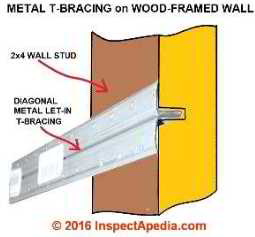 Watch out: Before choosing a metal strapping product for wall bracing check its specifications against what is required by local building codes where you live. Holladay, in an excellent Fine Homebuilding article on shear bracing points out that these products vary in strength, purpose, and acceptability.
Watch out: Before choosing a metal strapping product for wall bracing check its specifications against what is required by local building codes where you live. Holladay, in an excellent Fine Homebuilding article on shear bracing points out that these products vary in strength, purpose, and acceptability.
You'll want to confirm design alternatives and your choice of wall bracing methods with a structural engineer to obtain a sign-off, but there are alternatives once you've removed moldy drywall, cleaned the wall cavities and sanitized them.
Other suggstions for flood restoration including at brick veneer walls over fiberboard sheathing
Insulation retrofits: Some of our readers have re-insulated wall cavities using a combination of styrofoam cut to fit, foam insulation, and fiberglass.
We presently are working on adding photographs and discussion of that work here in this article. I think sticking fiberglass or any other water-vulnerable insulation back into a wall cavity that is likely to be exposed to future flooding is a bad idea.
Future flood resistance: I'm really glad to see you discussing water-resistant restoration material choices. I am concerned about some Louisiana flood restoration work being done that will be damaged again by the next flood and would prefer that owners, contractors, and insurance companies discuss use of materials and methods that may reduce the cost of damage from the next inundation.
Watch out for hidden mold and moisture damage in walls or ceilings above the actual flood high-water line. Homes that sat for more than 24-48 hours in wet and high humidity are at high risk of hidden mold damage in upper walls and ceiling cavities.
Simply running a dehumidifier or two along with fans will not "extract" water from the cavities of a flooded building and if not started soon enough it may not have prevented extensive but hidden mold contamination higher in the building.
A few strategic test cuts into those areas are worthwhile. Inspect the cavity side of drywall for visible mold. It's much less costly to do this repair now than to have to return to a "restored" flood-damaged home next year to rip out all of that new work to remove a just-discovered harmful mold reservoir in the building.
See HIDDEN MOLD in CEILINGS / WALLS for some examples of strategic test cuts into buildings.
Other hidden mold advice is at HIDDEN MOLD, HOW TO FIND
Watch out for leaving unsafe electrical devices in a flooded building: Be sure that you insist on review and qualification or probably replacement of electrical devices that were flooded in these walls, such as receptacles and splices.
Veneer Wall Vents: Should We Clean Out, Close, or Modify Brick Veneer Wall Vents After Flooding?
Also be sure to check for flood-clogged weep openings in brick veneer walls: those may need to be cleaned or opened as part of the restoration work lest wind-driven rain or other water later become trapped in the veneer wall cavity. See BRICK WALL DRAINAGE WEEP HOLES
Where upper sections of fiberboard sheathing are left in place on the building and when you are using closed cell foam insulation in the restored walls in order to improve future flood damage resistance, see BRICK VENEER WALL REPAIRS in FLOOD PRONE AREAS where we describe moving the brick or stone veneer wall vents higher up the wall to an appropriate location.
Research on Structural Support & Shear Bracing Where Fiberboard Panels are in Use
- Erickson, E.C.O., Eng., "Rigidity and Strength of Wall Frames Braced with Metal Strapping", [PDF] US Forest Products Service, USDA, Agriculture-Madison, 1960, Report No. R1603,
- Holladay, Martin, "4 Options for Shear Bracing Foam-Sheathed Walls", Fine Homebuilding, The Taunton Press, Inc. 63 South Main St., PO Box 5506 Newtown, CT 06470-5506 USA Phone: 203-426-8171 , No. 220, retrieved 2016/09/28, original source: http://www.finehomebuilding.com/2011/05/19/4-options-for-shear-bracing-foam-sheathed-walls
- Luxford, Ronald Floyd, RIGIDITY AND STRENGTH OF FRAME WALLS SHEATHED WITH FIBERBOARD. Madison, Wis. [PDF] US Dept. of Agriculture, Forest Service, Forest Products Laboratory, 1957 No. 1151 retrieved 2017/07/30, original source: http://ir.library.oregonstate.edu/xmlui/bitstream/handle/1957/1136/FPL_1151ocr_rev.pdf?sequence=1
- Simpson Strong Tie, 20-Gauge 14 Ft. 2 In. Wall Bracing, Model RCWB14, Simpson Strong-Tie Company Inc., Tel: (800) 999-5099, Website: https://www2.strongtie.com
Research on Mold Contamination / Growth on Fiberboard LDF & MDF Panels & Products
- Chowl, Poo, T. Harpl, R. Meimbanl, J. A. Youngquist, and R. M. Rowe112. "Effects of Acetylation on the Dimensional Stability and Decay Resistance of
Kenaf ( Hibiscus cannabinus L. ) Fiberboard " [PDF] The International Research Group On Wood Preservation, 27th Annual Meeting
West Indies 19 May - 24 May, 1996(1996). IRG Secretariat Box 5607 S-114 86 Stockholm Sweden
Abstract:
The objective of this study was to investigate the influence of the acetylation treated kenaf fiber, Phenol-formaldehyde resin content level, and three fungi species on the dimensional stability and decay resistance of high density non-wood composition boards. A standard ASTM method was used to evaluate weight loss and thickness change.
The linear shrinkage and expansion of each species were also determined. All specimens were exposed to decay chambers for 16 weeks. Test results indicated that most of the main factors significantly influence the thickness, length changes, and decay resistance of the high density kenaf fiberboards. - Chung, Woo-Yang, Seung-Gon Wi, Hyeun-Jong Bae, and Byung-Dae Park. "Microscopic observation of wood-based composites exposed to fungal deterioration." Journal of Wood Science 45, no. 1 (1999): 64-68.
Abstract:
This study was conducted to investigate the susceptibility of various wood composite panels exposed to wood-deteriorating fungi. Five wood-attacking fungi (three mold fungi, one brown rot fungus, one white rot fungus) were inoculated into four types of commercial wood composite panels (plywood, oriented strand board, particleboard, and medium-density fiberboard).
One solid wood sample was included as a control. The attacking patterns of the fungi in each panel was observed by scanning electron microscopy.
The weight losses due to the exposure were compared. All wood composites were more or less susceptible to all fungi inoculated. The attacking mode of the fungi was highly dependent on the types of wood composite, which had inherently different shapes of voids owing to different shapes and characteristics of the raw furnish materials used.
Plywood and medium-density fiberboard showed a large weight loss after an 8-week exposure to decay fungi. Plywood is the most susceptible to white and brown rot fungi. This study indicates that all wood composite panels should undergo careful consideration to prevent fungal deterioration when they are used for exterior and humid interior applications. - Shi, J. L., D. Q. Yang, S. Y. Zhang, and B. Riedl. "Mold resistance of medium density fiberboard panels made from black spruce, hybrid poplar, larch and a mixture of SPF chips." European Journal of Wood and Wood Products 64, no. 3 (2006): 167-171.
- Wright, Minturn, Gerald J. Bakus, Abraham Ortiz, Bernard Ormsby, and Denise M. Barnes. "Computer image processing and automatic counting and measuring of fouling organisms." Computers in biology and medicine 21, no. 3 (1991): 173-180.
Use of Fungicidal Sprays, Sealants & Sanitizers on Moldy Fiberboard or Insulating Board
Question: House was flooded; we left it to dry. One expert tells us that we should paint the fiberboard with a microbial such as Fosters™, the other says to leave it alone.
(May 7, 2012) Anonymous said:
Our home was built in the mid 60s with beaverboard insulation. We have sided over the original wood siding using redwood.
In 2011, the semi basement house was flooded, with about 8 feet of water on the main floor. There was water in the house for over a month.
It was gutted, power washed, sprayed professionally with a moldicide and allowed to dry for the winter.
We have left the exterior because it is almost impossible to find redwood. It has been tested for mold by a professional, and except in one place, the mold level is "acceptable".
We are receiving conflicting advice, one expert tells us that we should paint the fiberboard with a microbial such as Fosters, the other says to leave it alone; painting it will seal any moisture in and create a breeding ground for any existing mold. What is your opinion?
Reply:
I don't know what "acceptable" means without objective data, site observations and something more than an unaccountable position from someone with whom you may have no recourse.
I'm also unclear about who saw what where.
But in my OPINION, given the cost and trouble of a gut renovation, I'd be inclined to use a fungicidal sealant on the interior of the wall cavities that have been cleaned and dried.
I suspect your'e also worrying about mold trapped between the exterior siding's interior surface and the outer surface of the wall sheathing.
If that's the case I'd make a few test explorations in the most-suspect areas and I'd study the wall construction; in a more thorough study I might use some vacuum testing to see if it is possible to pull mold from the exterior wall sheathing surface or siding backside into the wall cavity - simulating changing building wall cavity pressures.
Chances are you won't be able to pull much through the wall even at butt joints of the sheathing (those should be over studs anyway).
Mold on a building exterior should be cleaned and the mold-producing conditions corrected but it's not normally a hazard to building occupants unless you put your fingers in harmful mold and then into your eye.
Do not Rely on Just a Sanitizer on Flooded, Mold-contaminated Fiberboard
There are sanitizers and spray cleaners that can reduce mold growth or mold viability on surfaces but that still risk leaving harmful, toxic, pathogenic or allergenic particles in the building.
Cleaning the surface of flood-damaged and moldy fiberboard or drywall will not be effective. Leaving a large reservoir of such contaminants risks serious health hazards for future building occupants.
It's easy to clean mold from exposed hard surfaces and almost impossible to reliably remove it from soft goods such as drywall or moldy fiberboard.
It *might* be possible in theory to remove mold present *only* on the surface of a waxed, treated, sealed surface of fiberboard sheathing if you could expose both sides of that material for cleaning (you can't without total demolition) and *if* you could prove that the material's interior had remained dry and mold-free during area flooding (you can't).
OPINION: Short of demolition and removal of mold-contaminated soft goods, about the best you could do - and in my opinion this is rather dangerous - would be to disinfect as best you can, dry the area, and seal it thoroughly to preclude movement of harmful particles or gases into the occupied space.
But there are better approaches explored in this FAQs article and described in detail at BRICK VENEER WALL REPAIRS in FLOOD PRONE AREAS.
Beware of very-appealing shortcuts and magic bullets. When we face a very costly cure for a problem, the temptation to try something else is nearly overwhelming. That's quite reasonable if there are not high-cost, high-risk downsides that exist at high probability.
...
Continue reading at BRICK VENEER WALL REPAIRS in FLOOD PRONE AREAS - what to do if your brick veneer wall building has been flooded, for more about these questions and their answers.
Or see these
Recommended Articles
BRICK VENEER WALL LEAKS in FLOOD PRONE AREAS - avoiding or handling leaks of flood waters through a brick veneer wall
FIBERBOARD SHEATHING IDENTIFICATION
FIBERBOARD SHEATHING MOLD CONTAMINATION
FIBERBOARD SHEATHING - home
FLOOD DAMAGE REPAIR PRIORITIES
FLOOD & DISASTER BUILDING DAMAGE REPAIR PROCEDURES
MOLD ACTION GUIDE - WHAT TO DO ABOUT MOLD
Suggested citation for this web page
FIBERBOARD SHEATHING FLOOD & MOLD FAQs at InspectApedia.com - online encyclopedia of building & environmental inspection, testing, diagnosis, repair, & problem prevention advice.
Or see this
INDEX to RELATED ARTICLES: ARTICLE INDEX to BUILDING DAMAGE, DISASTER, REPAIRS
Or use the SEARCH BOX found below to Ask a Question or Search InspectApedia
Or see
INDEX to RELATED ARTICLES: ARTICLE INDEX to BUILDING ENVIRONMENT
Or use the SEARCH BOX found below to Ask a Question or Search InspectApedia
Ask a Question or Search InspectApedia
Questions & answers or comments about mold on fiberboard building products.
Try the search box just below, or if you prefer, post a question or comment in the Comments box below and we will respond promptly.
Search the InspectApedia website
Note: appearance of your Comment below may be delayed: if your comment contains an image, photograph, web link, or text that looks to the software as if it might be a web link, your posting will appear after it has been approved by a moderator. Apologies for the delay.
Only one image can be added per comment but you can post as many comments, and therefore images, as you like.
You will not receive a notification when a response to your question has been posted.
Please bookmark this page to make it easy for you to check back for our response.
IF above you see "Comment Form is loading comments..." then COMMENT BOX - countable.ca / bawkbox.com IS NOT WORKING.
In any case you are welcome to send an email directly to us at InspectApedia.com at editor@inspectApedia.com
We'll reply to you directly. Please help us help you by noting, in your email, the URL of the InspectApedia page where you wanted to comment.
Citations & References
In addition to any citations in the article above, a full list is available on request.
- ENVIRONMENTAL HEALTH & INVESTIGATION BIBLIOGRAPHY - our technical library on indoor air quality inspection, testing, laboratory procedures, forensic microscopy, etc.
- In addition to citations & references found in this article, see the research citations given at the end of the related articles found at our suggested
CONTINUE READING or RECOMMENDED ARTICLES.
- Carson, Dunlop & Associates Ltd., 120 Carlton Street Suite 407, Toronto ON M5A 4K2. Tel: (416) 964-9415 1-800-268-7070 Email: info@carsondunlop.com. Alan Carson is a past president of ASHI, the American Society of Home Inspectors.
Thanks to Alan Carson and Bob Dunlop, for permission for InspectAPedia to use text excerpts from The HOME REFERENCE BOOK - the Encyclopedia of Homes and to use illustrations from The ILLUSTRATED HOME .
Carson Dunlop Associates provides extensive home inspection education and report writing material. In gratitude we provide links to tsome Carson Dunlop Associates products and services.


